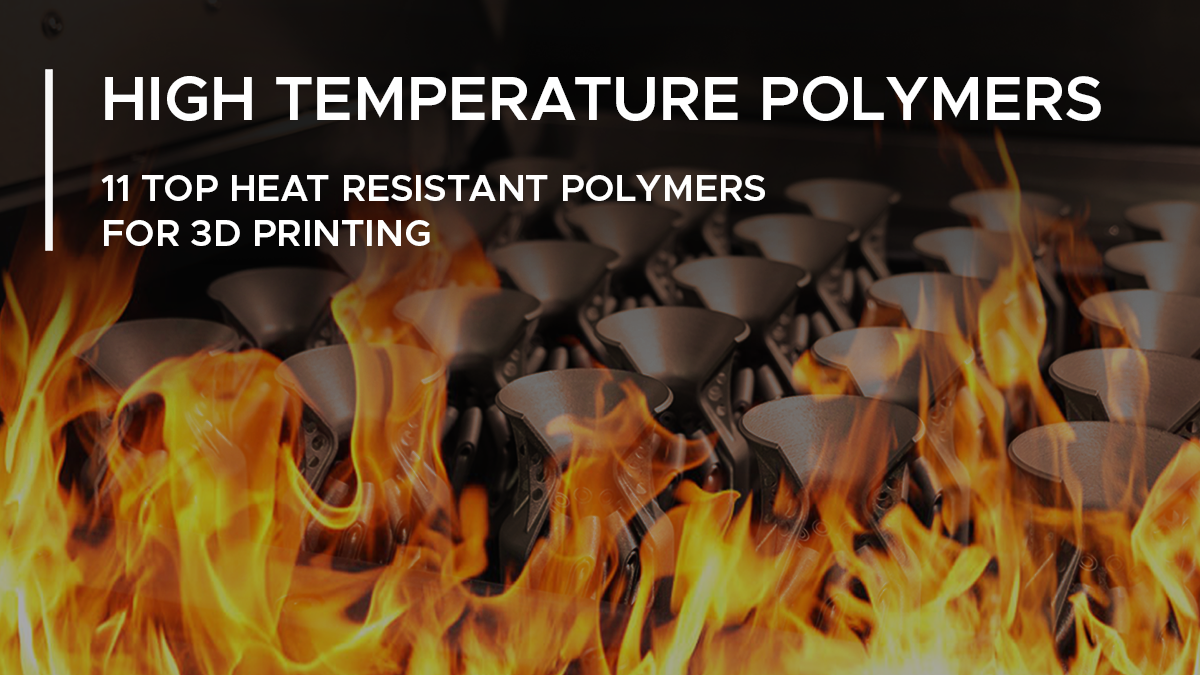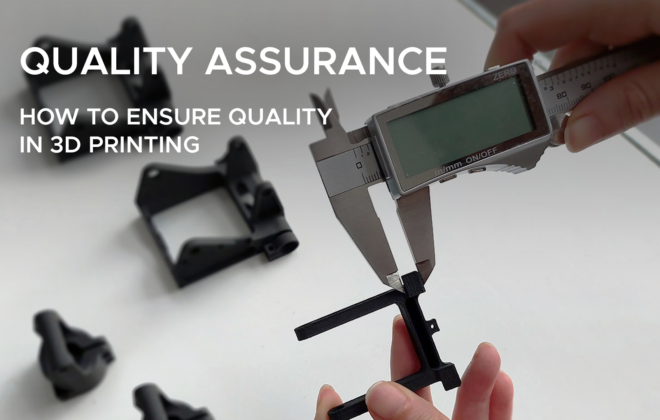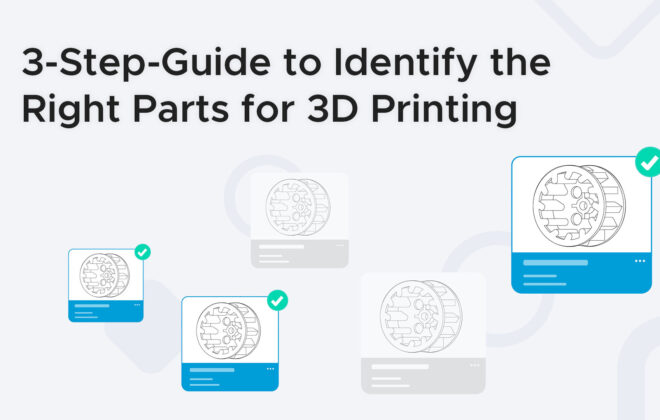11 top heat resistant 3D printing polymers
3D printing is being increasingly used for end-use applications. This of course comes with new and higher material requirements. One of the questions we regularly get asked is, which materials are actually heat resistant. In this article we therefore want to answer the question, by offering you an overview of heat resistant 3D printing materials which could aid in your decision-making process of your next 3D printing project.
What is heat resistance?
The most important measure to define heat resistance is the Heat Deflection Temperature (HDT). It defines the resistance to distortion under a given load at elevated temperature. To make it easier to understand you could also say it describes the stiffness of a material when temperature increases. Not only inherent properties of the polymer, but also any other added ingredients to the formulations can impact HDT, such as additives that increase the 3D printing performance. So if the additives for example make the material stiffer, it will also positively affect the heat resistance.
There are also other properties used to define heat resistance of 3D printing materials, mainly the Vicat softening temperature, indicating the point of softening when a material is used at elevated temperature; as well as the Transition Glass Temperature (Tg) that indicates when a crystalline or semi-crystalline material melts, and by that becoming amorphous.
However, HDT is the most adequate measure as it indicates mechanical performance at higher temperatures. Just keep in mind that HDT, Vicat and Tg are NOT interchangeable and comparable, as they measure different features.
What are the standards you have to look for in heat resistant materials?
There is a wide range of materials that can withstand high temperatures, from polyamides to other polymers that can work at temperatures above 260ºC. In addition to high temperature resistant polymers, the flame resistance of the various polymers is also noteworthy either because of the additives added to their formulation or because of their inherent flame resistance. Among the most common certifications for plastic flammability requirements are UL94 – the Standard for Safety of Flammability of Plastic Materials for Parts in Devices and Appliances testing – and FAR 25.853, a flammability standard of the Federal Aviation Administration. The UL94 classifies materials in various ranges according to the time it takes for the flame to stop and extinguish in the combustion test. In the case of UL94-V0 certification, the flame must stop in less than 10 seconds and no particles are allowed to fall from the flaming material. The FAR 25.853 Vertical Flammability Test is similar to the UL94 test, as it tests the self-extinguishing performance of a material that is on fire.
Overview of high temperature resistant 3D printing materials
After giving a small introduction into the topic let’s have a look at the materials that are widely used when it comes to heat resistance. We will describe the main features and benefits of the material and also show the HDT, as well as the tensile modulus, as it is an important parameter to show how resistant a material is.
PA11FR
PA11 is a polyamide of biological origin. Among 3D printing polymers, it stands out for its high toughness, ductility, low water absorption and impact resistance. It is also stable to light and UV radiation and therefore adapts well to different climate. PA11 FR is used in automotive and aerospace production, housing and enclosure assemblies, as well as electrical connector housings and clips. The material is certified to pass the FAR 25.853 60 second vertical burn requirement. The heat resistant 3D printing material is available in powder form for laser sintering (SLS) fabrication.
Properties of resistance
- HDT at 1.8 MPa (ºC): 70ºC
- HDT at 0.45 MPa (ºC): 186ºC
- Tensile strength (MPa): 45Mpa
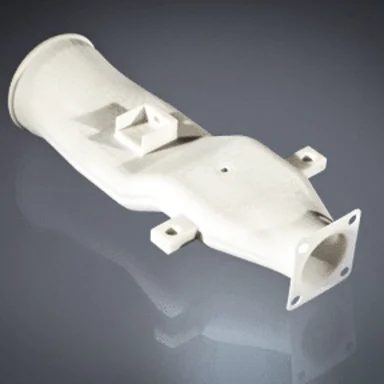
PA12FR
PA12 is a highly versatile polyamide. PA12 shows high fatigue and wear resistance, high stiffness and also good noise and vibration damping, which makes it a great material for the production of housings. It has high chemical resistance and high electrical resistance. It is also a good 3D printing material for detailed parts and texturing surfaces, and excellent for post-processing. PA12 is often used as a substitute for injection molding plastics. In the case of PA12FR, additives have been added to pass the FAR 25.853 60 second vertical burn certification. PA12FR is available in powder form for manufacturing by laser sintering (SLS).
Properties of resistance
- HDT at 1.8 MPa (ºC): 95ºC
- HDT at 0.45 MPa (ºC): 180ºC
- Tensile strength (MPa): 47Mpa
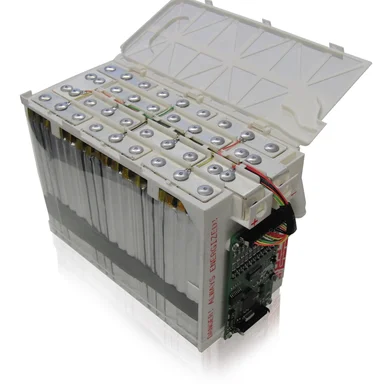
PA12 GF
PA12 GF is a mixture of Polyamide 12 filled with fiberglass. It has a high strength, allowing the 3D printing of parts that can withstand high stresses and loads. This makes PA12 GF ideal for machine parts.
Unfortunately, parts 3D printed with PA12 GF do not look as good as parts printed in unfilled PA12. PA12 GF is used for parts with high abrasion and wear resistance requirements. Due to its high strength under high temperatures, it is also used for parts that require particularly high heat distortion temperatures, low abrasive wear and special stiffness. An example of this are end parts in the automotive engine area.
PA12 GF is available in powder form to use in laser sintering machines (SLS) and multi jet fusion machines (MJF).
Properties of resistance
- HDT at 1.8 MPa (ºC): 96ºC
- HDT at 0.45 MPa (ºC): 157ºC
- Tensile strength (MPa): 52Mpa
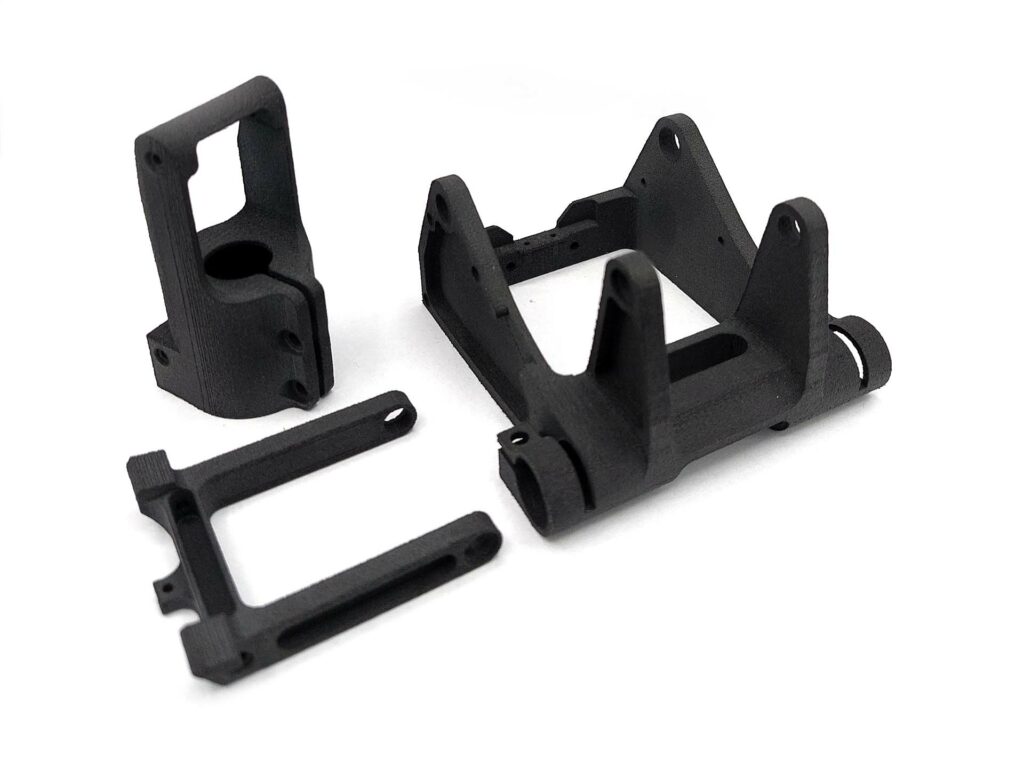
PC/ABS FR V-0
PC/ABS FR V-0 is a blend of polycarbonate and ABS, two thermoplastics widely used in electrical and engineering applications. The combination of the two materials results in excellent mechanical properties of PC and easy printing conditions of ABS.
PC/ABS FR V-0 comes in filament form used in FDM 3D printers, the lowest cost printing technology. PC/ABS FR V-0 is ideal for applications requiring flame retardant materials such as electrical and electronic component parts, automotive components or appliance housings. The material has higher thermal resistance than ABS and meets the flame retardancy requirements of UL94 V-0.
Properties of resistance
- HDT at 1.8 MPa (ºC): 79ºC
- HDT at 0.45 MPa (ºC): 86ºC
- Tensile strength (MPa): 50Mpa
Alumide (R)
Alumide is a mix of polyamide powder and fine aluminum particles. The mixture contains 50% aluminum, which gives it high temperature resistance. Alumide is often used when complex plastic parts are required that must have a particular high temperature resistance and high rigidity. Due to the presence of aluminum, alumide parts have good heat conductivity. Alumide also gives the parts a metallic appearance. It is available in powder form to use in laser sintering machines (SLS).
Properties of resistance
- HDT at 1.8 MPa (ºC): 146ºC
- HDT at 0.45 MPa (ºC): 177ºC
- Tensile strength (MPa): 45Mpa
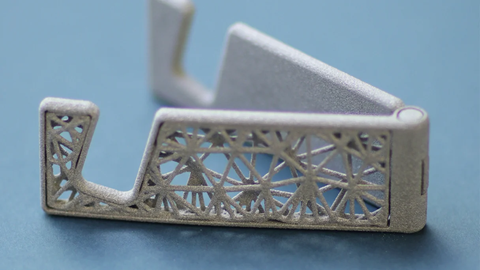
PA 640-GLS / PA12 GF CF
This material is a Polyamide 12 filled with carbon fiber and glass spheres. This makes the composite lighter than PA12. PA12 GF CF, also known as PA 640-GLS, has high dimensional stability and good stiffness. It is ideal for applications requiring low weight and high temperature resistance. Its characteristics make it ideal for aerospace applications, drone equipment, sports equipment, as well as sports and racing engine components. PA12 GF CF is available in powder form for laser sintering machines (SLS).
Properties of resistance
- HDT at 1.8 MPa (ºC): 151ºC
- HDT at 0.45 MPa (ºC): 178ºC
- Tensile strength (MPa): 49Mpa
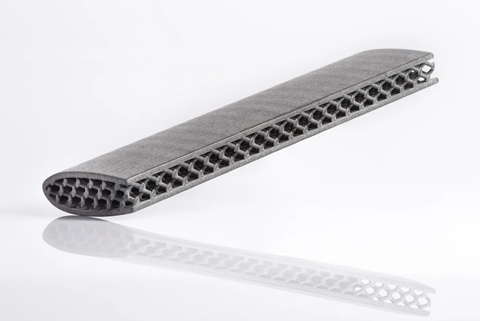
PPSU
PPSU is a high-performance 3D printing polymer with high heat resistance and excellent resistance to chemicals. It is used where other plastics cannot meet the requested performance specifications. PPSU has inherent flame retardancy properties, high mechanical strength and good insulating properties. It is used in electrical couplings, heater parts for pressurized fittings or manifolds as it can withstand high water temperatures and is water and gas tight. PPSU is also used in everyday objects because of its impact resistancy.
The inherent flame resistance of PPSU complies with UL94-V0. The polymer comes in filament form used in FDM 3D printers.
Properties of resistance
- HDT at 1.8 MPa (ºC): 211ºC
- HDT at 0.45 MPa (ºC): 215ºC
- Tensile strength (MPa): 74Mpa
PAHT CF
PAHT CF is a high-performance 3D printing material. It has good mechanical properties, high dimensional stability and high stiffness. It also has a high chemical resistance – higher than unfilled PA. It comes in filament form and is used in FDM technology, which has the lowest production costs, making PAHT CF ideal for high-performance applications and cost-sensitive parts. Applications for PAHT CF include automotive, drones, as well as industrial machinery parts and replacements.
Properties of resistance
- HDT at 1.8 MPa (ºC): 91ºC
- HDT at 0.45 MPa (ºC): 128ºC
- Tensile strength (MPa): 63Mpa
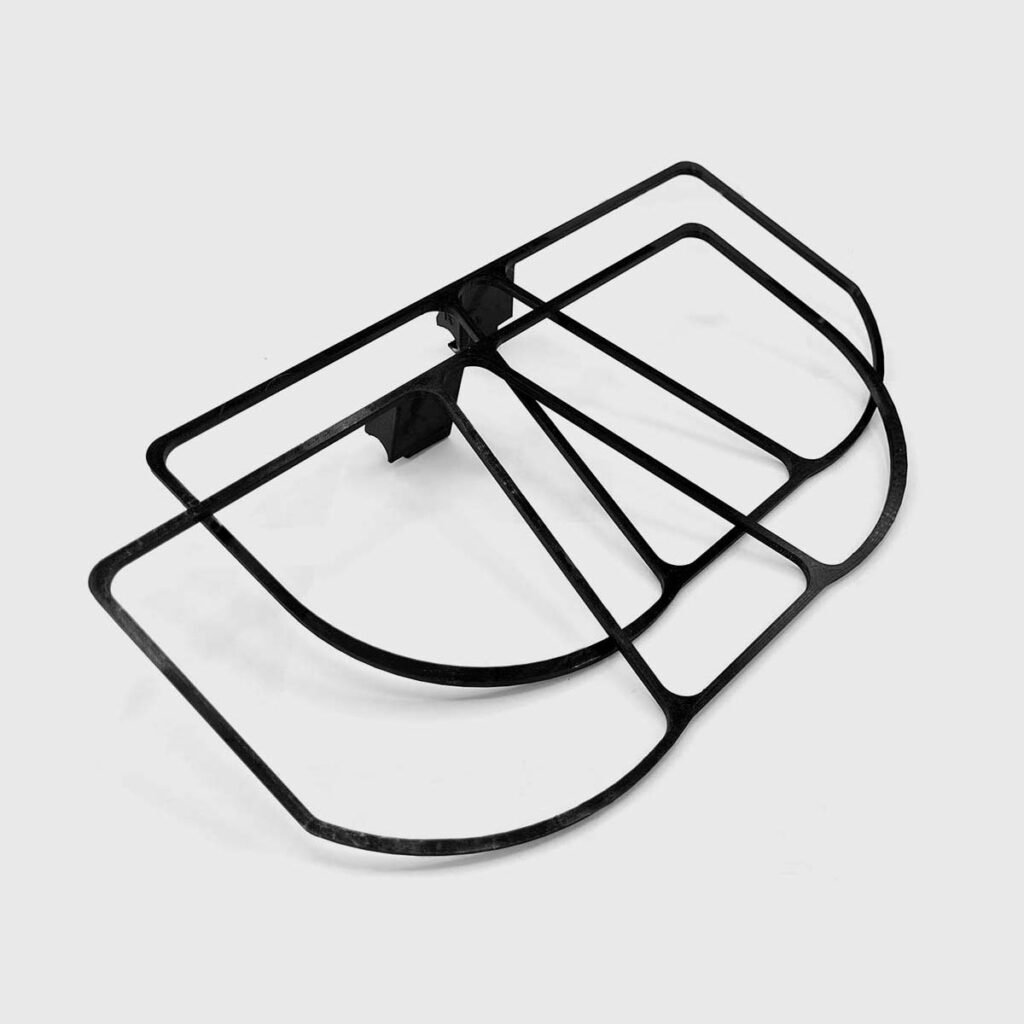
PAEK (polyaryletherketone) family: PEI, PEKK AND PEEK
The PAEK family are semi-crystalline thermoplastics with high mechanical, thermal and chemical resistance, as well as very low flammability and smoke emission. From the family, PEEK, PEKK and PEI are used in the additive manufacturing industry. They are mainly available in filament form for FDM printing, although PEKK sintering powders are also available.
PEI
The 3D printing material PEI is made from resin specifically developed to offer excellent chemical resistance, high heat resistance, as well as high strength and stiffness. It is developed for demanding applications and high temperature environments such as aerospace and automotive.
PEI has inherent flame resistancy and low smoke emission, making it suitable for electrical and electronic devices. It has a lower mechanical strength than PEEK but its price is much lower.
There are two PEI’s widely used in additive manufacturing: PEI9085 and PEI1010. PEI9085 is certified for aerospace industry according to FAR 25.853 and certified as UL94 V-0. PEI1010 is similar but is only certified as UL94-V0. PEI1010 is in general terms stronger and has a higher temperature resistance but a lower impact resistance than PEI9085.
Properties of resistance
PEI9085
- HDT at 1.8 MPa (ºC): 153ºC
- Tensile strenght (MPa): 86Mpa
PEI1010
- HDT at 1.8 MPa (ºC): 208ºC
- Tensile strenght (MPa): 90Mpa
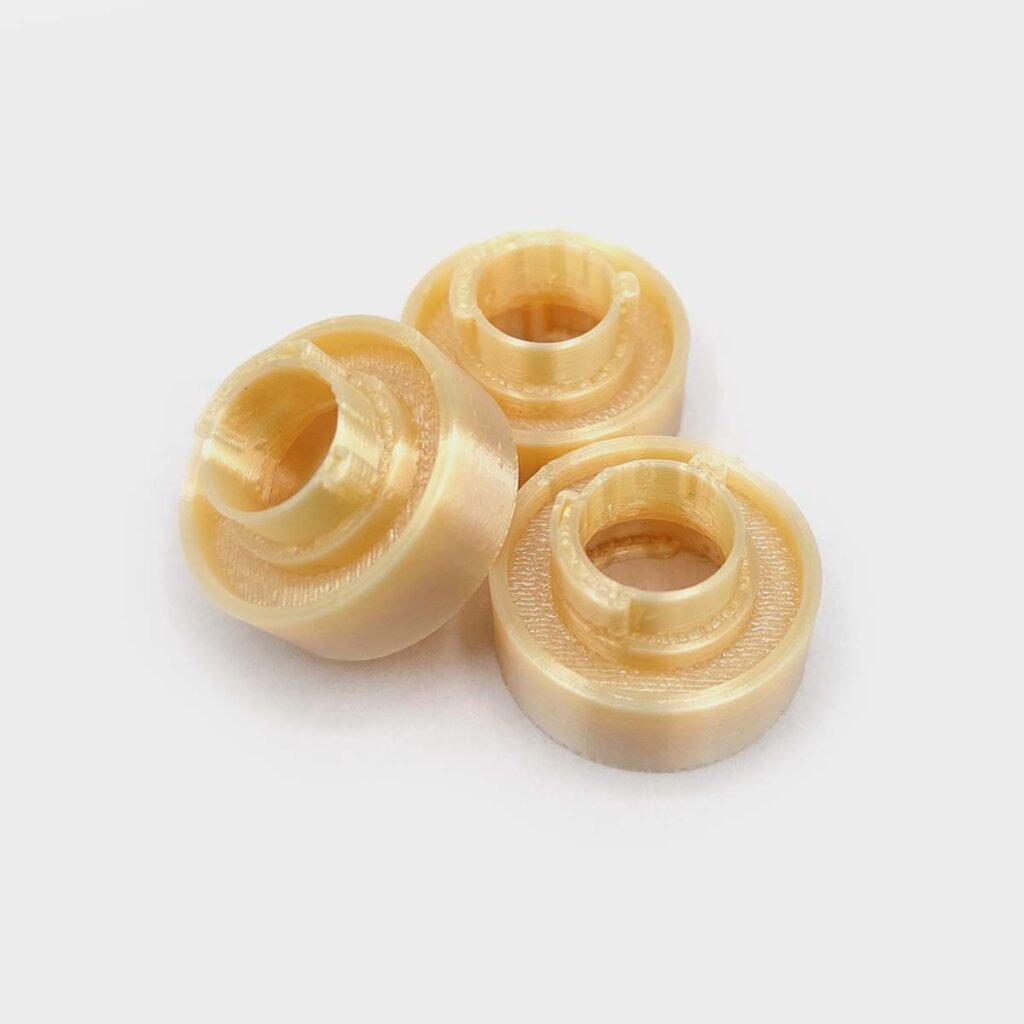
PEEK
The 3D printing material PEEK has excellent wear, fatigue and radiation resistance, low moisture absorption coefficient, high stiffness and a high dimensional stability. It has a very high chemical resistance and is therefore used for lightweight automotive components. Due to its insulating properties and wear resistance, it is also suitable for industrial and machinery parts requiring high temperature resistance.
PEEK is a biocompatible polymer and easy to sterilize, which is why its use in the medical industry is becoming more widespread, as it also meets the requirements for contact with food. There are versions of PEEK filled with carbon fiber which outstands the temperature resistance and mechanical properties of the material. The disadvantages of PEEK are its high price and the need to use a 3D printer suitable for working with materials that require high printing temperatures. Its inherent flame resistance complies with UL94-V0.
Properties of resistance
- HDT at 1.8 MPa (ºC): 159ºC
- Tensile strenght (MPa): 85Mpa
PEKK
The heat resistant 3D printing material PEKK can be presented in amorphous or semi-crystalline form.
Its semi-crystalline form PEKK-SC has a higher heat resistance than the amorphous form PEKK-A. PEKKK-SC crystallizes more quickly than the PEKK-A and may attain higher mechanical properties, but it is more difficult to 3D print. PEKKK-SC complies with the aerospace standard FAR25.853 and UL94-V0 standards. PEKK-A is easier to 3D print but has lower temperature resistance, and only meets UL94-V0 standards.
Compared to the former described PEEK, PEKK is easier to print and does not emit toxic gases during 3D printing. Extrusion temperatures are lower and in addition to being available in filament form there are also powders for sintering in SLS.
Properties of resistance
PEKK-SC
- HDT at 1.8 MPa (ºC): 172ºC
- Tensile strenght (MPa): 115Mpa
PEKK-A
- HDT at 1.8 MPa (ºC): 150ºC
- Tensile strenght (MPa): 105Mpa
Comparing the heat resistant 3D printing materials
When it comes to finding a heat resistant 3D printing material for your application, the options are plentiful. Of course, each material comes with its own benefits, disadvantages, cost points and skill levels. Additional features of the material can help finding the right material for your application. In the overview below you can see the described polymers with its tensile strenght and deflection temperature at 1,9 MPA in comparison.
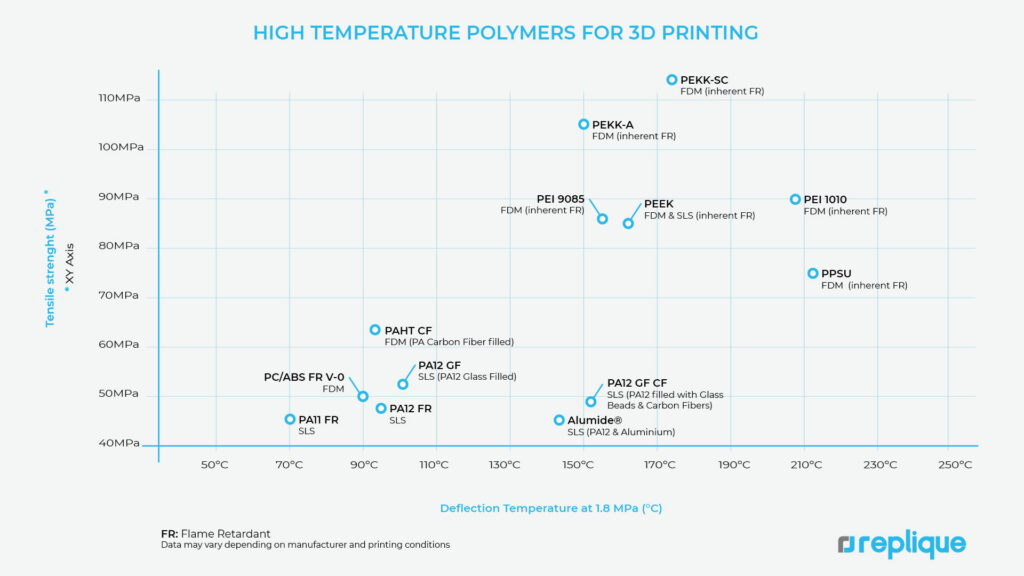
Categories
- 3D printing industries (5)
- 3D Printing Materials (1)
- Basics (3)
- News (1)
- Point of View (7)
- Press (17)
- Press (17)
- Sustainability (3)
- Technology (5)
- Uncategorized (1)
- White Paper (1)
